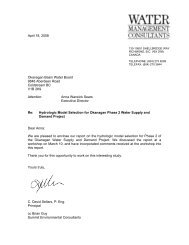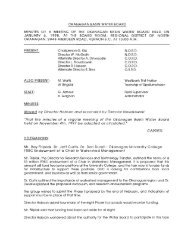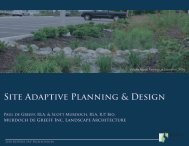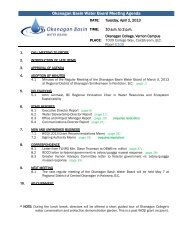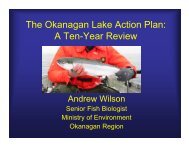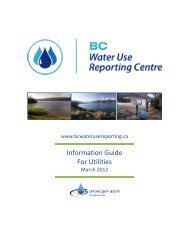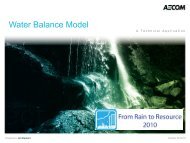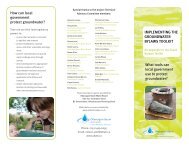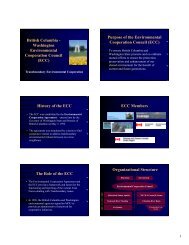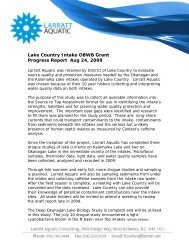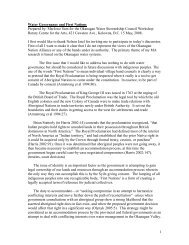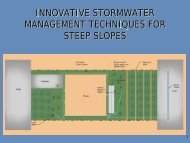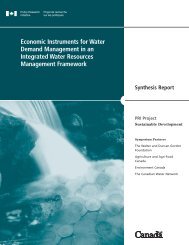- Page 2 and 3: Instream Flow Needs Analysis for th
- Page 4 and 5: ESSA Technologies Ltd.1765 West 8th
- Page 7 and 8: FINALOkanagan Basin Instream Flow N
- Page 9 and 10: FINALOkanagan Basin Instream Flow N
- Page 13 and 14: FINALOkanagan Basin Instream Flow N
- Page 15 and 16: FINALOkanagan Basin Instream Flow N
- Page 17 and 18: FINALOkanagan Basin Instream Flow N
- Page 19 and 20: FINALOkanagan Basin Instream Flow N
- Page 21 and 22: FINALOkanagan Basin Instream Flow N
- Page 23 and 24: FINALOkanagan Basin Instream Flow N
- Page 25 and 26: FINALOkanagan Basin Instream Flow N
- Page 27 and 28: FINALOkanagan Basin Instream Flow N
- Page 29 and 30: FINALOkanagan Basin Instream Flow N
- Page 31 and 32: FINALOkanagan Basin Instream Flow N
- Page 33: FINALOkanagan Basin Instream Flow N
- Page 36 and 37: FINALOkanagan Basin Instream Flow N
- Page 38 and 39: FINALOkanagan Basin Instream Flow N
- Page 40 and 41: FINALOkanagan Basin Instream Flow N
- Page 42 and 43: FINALOkanagan Basin Instream Flow N
- Page 46 and 47: FINALOkanagan Basin Instream Flow N
- Page 48 and 49: FINALOkanagan Basin Instream Flow N
- Page 50 and 51: FINALOkanagan Basin Instream Flow N
- Page 52 and 53: FINALOkanagan Basin Instream Flow N
- Page 54 and 55: FINALOkanagan Basin Instream Flow N
- Page 56 and 57: FINALOkanagan Basin Instream Flow N
- Page 58 and 59: FINALOkanagan Basin Instream Flow N
- Page 60 and 61: FINALOkanagan Basin Instream Flow N
- Page 62 and 63: FINALOkanagan Basin Instream Flow N
- Page 64 and 65: FINALOkanagan Basin Instream Flow N
- Page 66 and 67: FINALOkanagan Basin Instream Flow N
- Page 68 and 69: FINALOkanagan Basin Instream Flow N
- Page 70 and 71: FINALOkanagan Basin Instream Flow N
- Page 72 and 73: FINALOkanagan Basin Instream Flow N
- Page 74 and 75: FINALOkanagan Basin Instream Flow N
- Page 76 and 77: FINALOkanagan Basin Instream Flow N
- Page 78 and 79: FINALOkanagan Basin Instream Flow N
- Page 80 and 81: FINALOkanagan Basin Instream Flow N
- Page 82 and 83: FINALOkanagan Basin Instream Flow N
- Page 84 and 85: FINALOkanagan Basin Instream Flow N
- Page 86 and 87: FINALOkanagan Basin Instream Flow N
- Page 88 and 89: FINALOkanagan Basin Instream Flow N
- Page 90 and 91: FINALOkanagan Basin Instream Flow N
- Page 92 and 93: FINALOkanagan Basin Instream Flow N
- Page 94 and 95:
FINALOkanagan Basin Instream Flow N
- Page 96 and 97:
FINALOkanagan Basin Instream Flow N
- Page 98 and 99:
FINALOkanagan Basin Instream Flow N
- Page 100 and 101:
FINALOkanagan Basin Instream Flow N
- Page 102 and 103:
FINALOkanagan Basin Instream Flow N
- Page 104 and 105:
FINALOkanagan Basin Instream Flow N
- Page 106 and 107:
FINALOkanagan Basin Instream Flow N
- Page 108 and 109:
FINALOkanagan Basin Instream Flow N
- Page 110 and 111:
FINALOkanagan Basin Instream Flow N
- Page 112 and 113:
FINALOkanagan Basin Instream Flow N
- Page 114 and 115:
FINALOkanagan Basin Instream Flow N
- Page 116 and 117:
FINALOkanagan Basin Instream Flow N
- Page 118 and 119:
FINALOkanagan Basin Instream Flow N
- Page 120 and 121:
FINALOkanagan Basin Instream Flow N
- Page 122 and 123:
FINALOkanagan Basin Instream Flow N
- Page 124 and 125:
FINALOkanagan Basin Instream Flow N
- Page 126 and 127:
FINALOkanagan Basin Instream Flow N
- Page 128 and 129:
FINALOkanagan Basin Instream Flow N
- Page 130 and 131:
FINALOkanagan Basin Instream Flow N
- Page 132 and 133:
FINALOkanagan Basin Instream Flow N
- Page 134 and 135:
FINALOkanagan Basin Instream Flow N
- Page 136 and 137:
FINALOkanagan Basin Instream Flow N
- Page 138 and 139:
FINALOkanagan Basin Instream Flow N
- Page 140 and 141:
FINALOkanagan Basin Instream Flow N
- Page 142 and 143:
FINALOkanagan Basin Instream Flow N
- Page 144 and 145:
FINALOkanagan Basin Instream Flow N
- Page 146 and 147:
FINALOkanagan Basin Instream Flow N
- Page 148 and 149:
FINALOkanagan Basin Instream Flow N
- Page 150 and 151:
FINALOkanagan Basin Instream Flow N
- Page 152 and 153:
FINALOkanagan Basin Instream Flow N
- Page 154 and 155:
FINALOkanagan Basin Instream Flow N
- Page 156 and 157:
FINALOkanagan Basin Instream Flow N
- Page 158 and 159:
FINALOkanagan Basin Instream Flow N
- Page 160 and 161:
FINALOkanagan Basin Instream Flow N
- Page 162 and 163:
FINALOkanagan Basin Instream Flow N
- Page 164 and 165:
FINALOkanagan Basin Instream Flow N
- Page 166 and 167:
FINALOkanagan Basin Instream Flow N
- Page 168 and 169:
FINALOkanagan Basin Instream Flow N
- Page 170 and 171:
FINALOkanagan Basin Instream Flow N
- Page 172 and 173:
FINALOkanagan Basin Instream Flow N
- Page 174:
FINALOkanagan Basin Instream Flow N



